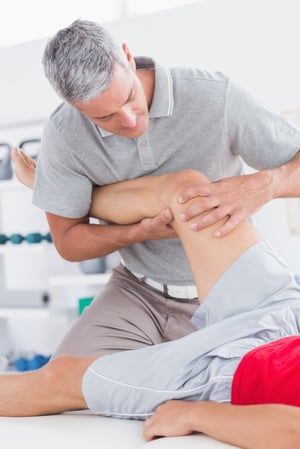A groin strain injury can happen to anybody, but it is most common in athletes, and particularly those who play soccer, football, or hockey.1 The injury happens when the muscles in the groin area contract too suddenly, causing a painful stretch or tear in the muscle tissue.2 How do you know if you have a groin strain injury?
You will feel pain in the inner thigh, and depending on the severity of the injury, you might also experience2:
- Loss of strength in the affected muscles.
- Loss of range of motion.
- Tenderness caused by swelling in the inner thigh.
- Difficulty lifting your knee or bringing your knees together.
Before self-diagnosing, especially if you’ve never had a groin strain before, see a healthcare professional. A few simple home care tips may help speed recovery and reduce the risk of long-term pain.3
 Speeding up Groin Strain Recovery
Speeding up Groin Strain Recovery
The faster you recover, the less time you’ll spend in pain. Faster recovery also means getting back to your regular activities more quickly, so it’s worth your time to educate yourself about groin strain recovery. Talk to your doctor before starting any course of treatment, and make sure you don’t have any other associated injuries that should also be treated.
Some of the ways you can help speed up your recovery include3:
-
Rest
No athlete wants to hear that they have to rest, especially mid-season. However, like with any injury, if your damaged tissues don’t have a chance to properly heal, the recovery process can ultimately take longer, and you run the risk of exacerbating the injury. Resting doesn’t always mean you have to be bedridden. In fact, remaining active while you rest the injured muscles can help you stay fit so you may be able to return to activity even faster when the recovery process is complete. Instead, rest is all about avoiding unnecessary strain on the groin, so avoid kicking, intense exercises such as running, and heavy lifting. If the pain is intense, avoid walking or any physical activity for a day or two following the injury.3
-
Cryotherapy
Cryotherapy, or cold therapy, is a proven method for reducing pain and inflammation in the soft tissues. Cold reduces inflammation, which can help with pain and support a quicker recovery.4 In fact, the faster you can apply cold to the injured area, the quicker your groin strain recovery may be. Many athletes make the mistake of icing an injury for only a few days after it has happened. However, the therapeutic application of cold works throughout the entire recovery process. Try applying cold several times each day. In addition to dulling the pain and reducing swelling, cryotherapy also helps slow down cellular metabolism, which allows healing to happen more quickly.5
-
Compression
Applying a compression bandage to the groin area may also help minimize swelling, which can help with pain and mobility. Make sure that the bandage is applied in such a way that there is enough compression to have an impact, but not so much that circulation is affected. If the legs or hips become numb or tingly, or the skin near the compression bandage changes color, it could be a sign of low circulation and compression that is too tight.3
-
Anti-inflammatory medication
Your doctor might recommend the temporary use of nonsteroidal anti-inflammatory drugs (NSAIDs) to help reduce inflammation, particularly in the first few days after the injury. Make sure you understand all of the potential side effects and follow your doctor’s dosage recommendations.
-
Physical therapy
Strengthening and stretching the injured muscles are an important part of the groin strain recovery process, but it is important that you do not do too much too soon. A qualified physical therapist or trainer can recommend appropriate exercises and tell you how often to perform them.3
If you want to make the groin strain recovery process easier, consider using cold therapy.
References
- Antonios A. Osteitis pubis in elite athletes: Diagnostic and therapeutic approach. World Journal of Orthopedics. 2015;6(9):672-679. doi:10.5312/wjo.v6.i9.672.
- Baker L. Groin strain. Healthline. https://www.healthline.com/health/groin-strain. Published August 15, 2017.
- Tyler TF, Fukunaga T, Gellert J. Rehabilitation of soft tissue injuries of the hip and pelvis. International Journal of Sports Physical Therapy. 2014;9(6):785-797. https://www.ncbi.nlm.nih.gov/pmc/articles/PMC4223288/.
- Peake JM, Roberts LA, Figueiredo VC, et al. The effects of cold water immersion and active recovery on inflammation and cell stress responses in human skeletal muscle after resistance exercise. The Journal of Physiology. 2017;595(3):695-711. doi:10.1113/jp272881.
- Chandler S. The effect of temperature on cell membranes. Sciencing. https://sciencing.com/effect-temperature-cell-membranes-5516866.html. Published March 13, 2018.